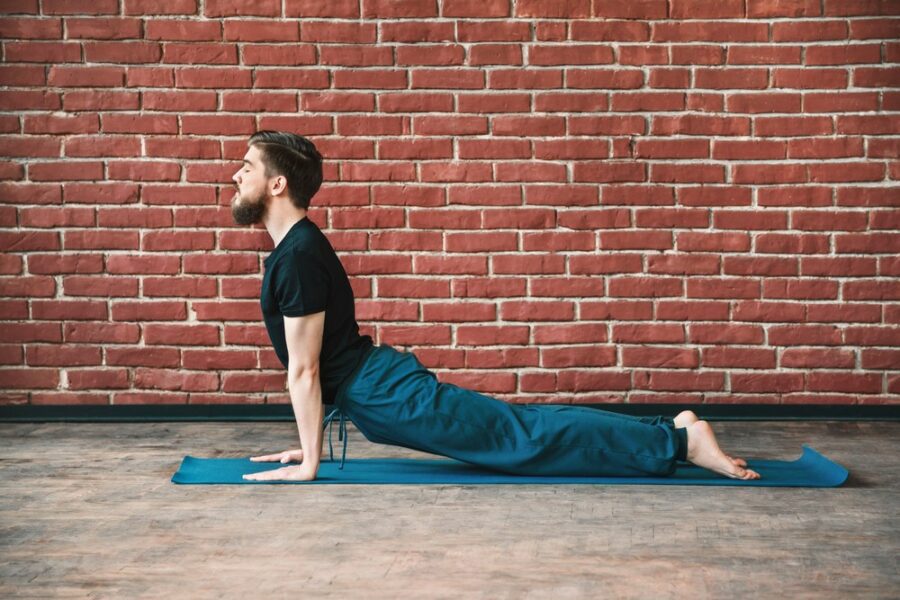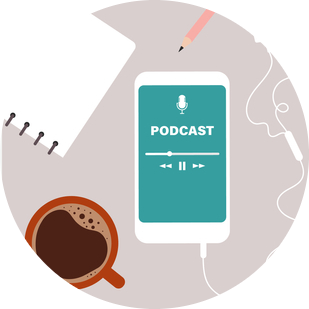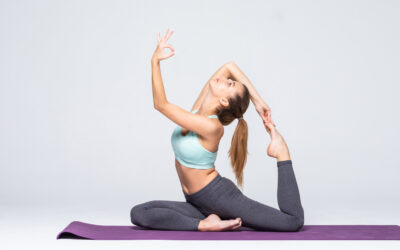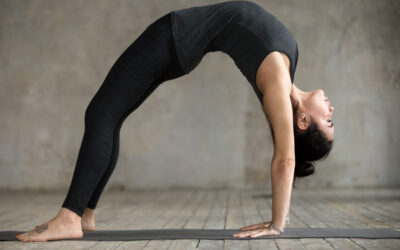Seal pose yoga, also known as Bhujangasana , is a gentle yoga pose that can be done to relax the body and mind. It is a great pose for anyone looking to stretch and strengthen their core muscles. This step-by-step guide will provide you with an easy way to practice seal pose yoga, so that you can reap the benefits of this calming posture.
Benefits of Seal Pose Yoga.
Seal pose yoga is a popular yoga asana that is beneficial for your overall health and well-being. Here are some of the benefits of practicing Bhujangasana:
1. Strengthens the Spine.
Seal pose yoga helps to stretch and strengthen the spine, which can relieve back pain and improve posture.(1)
2. Tones the Abdomen.
This pose engages the abdominal muscles, toning and strengthening them. Regular practice can help to reduce belly fat and improve digestion.
3. Increases Flexibility.
Seal pose yoga stretches the chest, shoulders and neck, increasing flexibility in those areas. It also stretches the muscles in the back, hips and thighs, improving overall flexibility.
4. Improves Circulation.
Seal pose yoga stimulates blood flow throughout the body, improving circulation and oxygenation of the cells.
5. Reduces Stress.
Seal pose yoga is a gentle backbend that can help to reduce stress and anxiety. It can also improve mood and increase energy levels.
6. Boosts Immunity.
The Seal pose yoga stimulates the thymus gland, which is responsible for producing T-cells, a type of white blood cell that helps to fight infection and disease.
7. Improves Respiratory Health.
This pose opens up the chest and lungs, improving respiratory health and increasing lung capacity.
Overall, practicing Seal pose yoga regularly can help to improve your physical, mental and emotional health, leaving you feeling stronger, more flexible and more relaxed.
How to Do Seal Pose Yoga?
It is a simple yet powerful pose that is accessible to beginners and advanced practitioners alike. Here is a step-by-step guide on how to do Seal pose yoga:
Step 1. Lie flat on your stomach, with your legs stretched out behind you and your toes pointing away from your body.
Step 2. Place your hands on the ground directly under your shoulders, with your fingers pointed forward. Your elbows should be tucked in close to your body.
Step 3. Inhale deeply and slowly lift your head and chest off the ground. Keep your elbows tucked in and use your back muscles to lift your upper body.
Step 4. As you lift your head and chest, press your palms firmly into the ground to lift your torso even higher. Keep your shoulders relaxed and away from your ears.
Step 5. Hold the pose for a few seconds, breathing deeply. Keep your gaze forward or slightly upward.
Step 6. Exhale and slowly lower your upper body back down to the ground, releasing your hands from the ground.
Step 7. Repeat the pose 2-3 times, gradually increasing the duration of the hold each time.
things to keep in mind while practicing.
- Take care not to strain your back or neck. If you feel any pain, release the pose immediately and rest for a few breaths before trying again.
- Keep your movements slow and controlled, focusing on the sensation in your back muscles.
- If you have any pre-existing spinal or back injuries, consult with a qualified yoga instructor before attempting this pose.
Overall, Seal pose yoga is a wonderful pose for improving spinal strength and flexibility, as well as relieving tension in the back muscles. With consistent practice, you will gradually build greater strength and ease in this pose.
Tips for Success.
Seal pose is a powerful yoga posture that can help to improve flexibility, reduce stress and strengthen the back, arms and shoulders. Here are some helpful tips to keep in mind when practicing Seal pose:
1. Warm-up.
Before starting Seal pose yoga, it is important to warm up your body with some gentle stretches and movements. This can help to prevent injury and prepare your muscles for the more intense stretching and bending that comes with the pose.
2. Breathe Deeply.
Throughout the posture, focus on taking deep, slow breaths. This can help to release tension in the body and promote a sense of calm and relaxation.
3. Align Your Body Correctly.
When practicing Seal pose yoga, make sure your hands are placed directly under your shoulders, your elbows are tucked in close to your body and your feet are hip-width apart. This will help you to maintain proper alignment and avoid strain on your neck or lower back.
4. Gradually Increase Your Stretch.
As you ease into the pose, gradually lift your chest and extend your arms further. Make sure to move slowly and listen to your body, stopping if you feel any pain or discomfort.
5. Hold the Pose.
To get the full benefits of Seal pose, hold the pose for at least 15-30 seconds. Focus on maintaining a steady breath and keeping your body relaxed.
6. Release Slowly.
When coming out of the pose, release slowly and gently, lowering your chest and forehead back down to the mat. Take a few deep breaths before moving on to the next posture.
By following these tips for success, you can make the most of your Seal pose practice and enjoy the many benefits of this powerful yoga posture.
Common Mistakes.
Although it is a relatively simple pose, there are some common mistakes that people tend to make when performing it. These mistakes can not only reduce the effectiveness of the pose but also lead to injuries.
1. One of the most common mistakes people make when practicing Seal pose is lifting their shoulders up towards their ears. This can cause tension in the neck and shoulders and prevent the spine from extending fully. To avoid this, it is important to keep the shoulders relaxed and away from the ears.
2. Another mistake people make is pushing themselves too far into the pose, resulting in a deep arch in the lower back. This can cause strain on the lower back and lead to pain or injury. To prevent this, it is important to engage the core muscles and only lift the chest as far as is comfortable.
3. A third common mistake is failing to engage the legs and feet. In Seal pose, the legs should be active and engaged, with the tops of the feet pressing into the mat. This helps to support the lower back and maintain a stable base.
4. Finally, many people tend to hold their breath while in the pose. This can create tension in the body and prevent you from fully relaxing into the posture. Instead, focus on breathing deeply and rhythmically, inhaling as you lift the chest and exhaling as you release back down to the mat.
By avoiding these common mistakes and practicing Seal pose with awareness and intention, you can experience the full benefits of this powerful yoga posture.
Variations of Seal Pose Yoga.
There are many variations of Seal pose yoga or Bhujangasana that can be practiced to further enhance these benefits and add variety to your yoga practice.
1. Sphinx Pose.

This Sphinx Pose is similar to Seal pose, but the arms are placed in front of the body instead of being straightened. This variation is great for beginners and those with limited mobility in their arms and shoulders.
2. Upward Facing Dog Pose.

This variation involves lifting the hips off the ground and straightening the arms. This pose is more advanced and requires more strength and flexibility in the upper body.
3. Cobra Twist Pose.

This variation involves twisting the torso to one side while in the Seal pose. This pose is great for improving spinal mobility and strengthening the obliques.
4. King Cobra Pose.

This variation involves lifting the chest higher off the ground and bringing the hands further back towards the hips. This pose is more advanced and requires more flexibility in the spine.
Overall, practicing these variations of Seal pose can help you to improve your back strength, flexibility and mobility. They can also add variety and challenge to your yoga practice. However, it’s important to listen to your body and only practice poses that feel comfortable and safe for you.
Best Time To Do Seal Pose Yoga.
The best time to do Seal pose is in the morning, on an empty stomach. This is because the body is well-rested and energized after a good night’s sleep and the digestive system is empty, making it easier to perform the pose.
Additionally, practicing Seal pose in the morning can help to improve metabolism and kickstart the day on a positive note.
However, if you are unable to practice it in the morning, you can also do it in the evening, after a gap of at least four to six hours after meals. This will ensure that your body is not too heavy or full, making it easier to perform the pose. It can also help to relax the body after a long day and prepare you for a good night’s sleep.
It is important to note that Seal pose should not be performed immediately after a meal, as it can lead to discomfort and hinder digestion. Also, ensure that you practice the pose in a quiet and peaceful environment, free from distractions, to get the maximum benefits from it.
Finally, it is essential to listen to your body and not force yourself into the pose if you are not comfortable. Take it slow and steady, and with regular practice, you will soon be able to do Bhujangasana with ease and reap its many benefits.
Who Can Do Seal pose yoga?
Seal pose yoga, also known as the Cobra pose, is a yoga asana that can be practiced by people of all ages and fitness levels. However, it may not be suitable for everyone, especially those with certain medical conditions.
People who are looking to strengthen their back muscles, improve their posture and increase flexibility can benefit from practicing Seal pose yoga. It is also helpful for those who experience lower back pain, as it can help to alleviate tension in the muscles and improve spinal alignment.
Pregnant women should avoid practicing this pose as it puts pressure on the abdomen and can cause discomfort. People with herniated discs or sciatica should also avoid this pose, as it can exacerbate these conditions.
For beginners, it is important to start slowly and gradually build up to holding the pose for longer periods of time. It is also helpful to practice under the guidance of a certified yoga instructor to ensure proper alignment and prevent injury.
Overall, Seal pose is a beneficial yoga for most of the people and can be incorporated into a regular yoga practice for improved strength, flexibility and overall well-being.
Bottom Line.
Seal pose or the Cobra Pose is a beneficial yoga posture that can help in improving the strength and flexibility of the spine, shoulders and abdomen. It also helps in relieving stress, anxiety and fatigue and improves blood circulation and digestion. Practicing this asana regularly can also help in alleviating back pain and improving posture. However, it is important to practice this pose under the guidance of a trained yoga instructor and avoid overexertion or straining the muscles. With proper practice and mindfulness, Seal pose can be a great addition to one’s yoga routine and overall wellness.
+1 Source
Freaktofit has strict sourcing guidelines and relies on peer-reviewed studies, educational research institutes, and medical organizations. We avoid using tertiary references. You can learn more about how we ensure our content is accurate and up-to-date by reading our editorial policy.
- Effects of hatha yoga exercises on spine flexibility in women over 50 years old; https://www.ncbi.nlm.nih.gov/pmc/articles/PMC4339138/

 Workout
Workout
 Meditation
Meditation


 Stories
Stories


 Podcast
Podcast E-book
E-book











